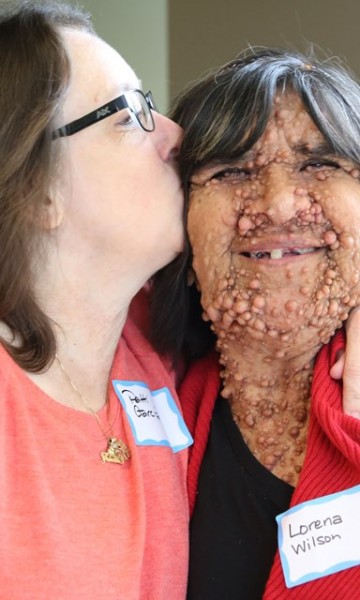be iNFormed – Gene Deletion in Neurofibromatosis-1
Written for NF Midwest by Heather Radtke, MS, CGC
Neurofibromatosis type 1 (NF1) is a genetic condition caused by mutations in the NF1gene on chromosome 17.
Genetics Review
Chromosomes are the packages of our genetic information. Inside each cell of the body are 46 chromosomes arranged in 23 pairs. One chromosome in each pair is inherited from the mother and the other from the father. The pairs are numbered by their size. The number 1 chromosome pair is the largest and the number 22 is the smallest. The last pair of chromosomes (the sex chromosomes) help to determine sex. Genes are small areas along the chromosomes, and are the body’s blueprint or instructions. We have approximately 20,000 genes that control how we grow and develop and what we look like. Each gene can be thought of as a sentence made up of four letters (A, T, C, and G). Changes in a gene’s letters (mutations) can make a gene not work the way that it should. There are several different types of mutations including translocations/inversions (rearranging the letters), deletions (taking letters out), duplications (putting extra letters in), or changing a single letter in the sentence. Individuals with NF1 have a mutation in one of their two NF1 genes located on chromosome 17. The NF1 gene is an important gene in regulating cell growth and development and is referred to as a tumor suppressor gene. Some specific gene changes are common among many people with NF1, while others are unique to a specific family.
Approximately 5% of individuals with a diagnosis of NF1 have a deletion that includes the entire NF1 gene. When the entire NF1 gene is missing, it is referred to as an NF1 (whole) gene deletion. Some people also call this an NF1 microdeletion. The deletion may include other nearby genes. Some of the surrounding genes are important for cognitive functioning and body development. Individuals with an NF1 gene deletion are often, but not always, characterized by a more severe presentation than is observed in other individuals with NF1.
Individuals with the NF1 gene deletion often have earlier and more numerous neurofibromas, as well as an increased risk of transformation of plexiform neurofibromas into a malignant/cancerous form of a tumor. Cardiac malformations and scoliosis are also more common in individuals with a whole NF1 gene deletion. In addition, most individuals with an NF1 gene deletion have more significant learning and developmental issues, and intellectual disability may be present.
Other observed findings of some people with an NF1 gene deletion include tall stature, large hands and feet, and increased incidence of connective tissue findings such as joint hypermobility (flexible joints). Some individuals with an NF1 gene deletion have unique types of facial features, including hypertelorism (wide spaced eyes), ptosis (droopy eyelids) and micrognathia (small jaw). These symptoms may be subtle to most people and do not cause medical issues, but are simply observed more often when an NF1 gene deletion is present.
There is variability in both NF1 gene deletions and other NF1 gene mutations and one cannot determine the presence of a deletion based on clinical symptoms alone. Genetic testing is required to determine if an individual has an NF1 gene deletion or another NF1gene mutation. A family should be educated about the benefits, costs, possible outcomes and limitations of genetic testing prior to completing testing. Genetic testing does not always identify a genetic change to explain clinical features, and predictions cannot be made based on the result of a genetic testing alone. For further information about genetic testing or gene deletions, contact a genetic counselor (nsgc.org) or your NF provider.
References:
Mautner, V.-F., Kluwe, L., Friedrich, R. E., Roehl, A. C., Bammert, S., Hogel, J., Spori, H., Cooper, D. N., Kehrer-Sawatzki, H.Clinical characterisation of 29 neurofibromatosis type-1 patients with molecularly ascertained 1.4 Mb type-1 NF1 deletions.J. Med. Genet. 47: 623-630, 2010.
Tonsgard, J. H., Yelavarthi, K. K., Cushner, S., Priscilla Short, M. and Lindgren, V. (1997), Do NF1 gene deletions result in a characteristic phenotype?. Am. J. Med. Genet., 73: 80–86.
Venturin, M., Guarnieri, P., Natacci, F., Stabile, M., Tenconi, R., Clementi, M., Hernandez, C., Thompson, P., Upadhyaya, M., Larizza, L., Riva, P.Mental retardation and cardiovascular malformations in NF1 microdeleted patients point to candidate genes in 17q11.2. J. Med. Genet. 41: 35-41, 2004.







.png)





Hello,
My name is April and I am 27 yrs old and I have NF1. For the longest time we couldn’t figure out where my NF came from because the doctors told us it was genetic and we were tracking that I was the only on in my family who had it. This past year we found out my grandfathers uncle had NF. I recently got married and we are thinking about children. From my research I read that there was a 50% chance my future kids could have NF, is there a greater odds of a girl having it over a boy? or if I did have kids and there were born without NF could they pass it down to their children?
It just really scares me, school was hard but I have been blessed with no tumors and about to finish my masters.
April,
Congratulations on your masters! You are correct in that there is a 50% chance of passing NF to your children, yet NF doesn’t discriminate. We have a great article on reproductive options:
http://www.nfmidwest.org/wp-content/uploads/2012/09/Reproductive-Options-NF-Midwest.pdf